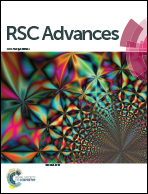Green synthesis of zinc oxide nanoparticles and their effect on the stability and activity of proteinase K
Abstract
The use of environmentally benign materials for the synthesis of zinc oxide nanoparticles offers numerous benefits of eco-friendliness and compatibility for pharmaceutical, biotechnological and biological applications. In this paper, for the first time, we report on the use of coffee powder extract in the biosynthesis of ZnO nanoparticles. Furthermore, the effect of calcination time (at 600 °C) on the size of ZnO nanoparticles was investigated. The samples were characterized using transmission electron microscopy (TEM), scanning electron microscopy (SEM), energy dispersive X-ray spectroscopy (EDX) X-ray diffraction pattern (XRD), and Fourier transform infrared spectroscopy (FT-IR). Then, the influence of green synthesized ZnO nanoparticles calcined at 600 °C for 2 h on proteinase K was investigated. The enzyme activity of proteinase K showed that ZnO nanoparticles inhibited the activity of the enzyme and its thermal stability was increased by enhancing the concentration of nanoparticles. Far-UV circular dichroism (CD) studies showed that ZnO nanoparticles could change the secondary structure of proteinase K via increasing the content of the α-helix structure and decreasing the β-sheet. The fluorescence spectroscopic experiments revealed that ZnO nanoparticles had the ability to quench the intrinsic fluorescence of proteinase K through a static quenching procedure. The binding constant was determined using the Stern–Volmer equation. The thermodynamic parameters also indicated that the binding process was spontaneous and that hydrogen bonds and van der Waals forces played a major role in the interaction of ZnO nanoparticles with proteinase K.


 Please wait while we load your content...
Please wait while we load your content...